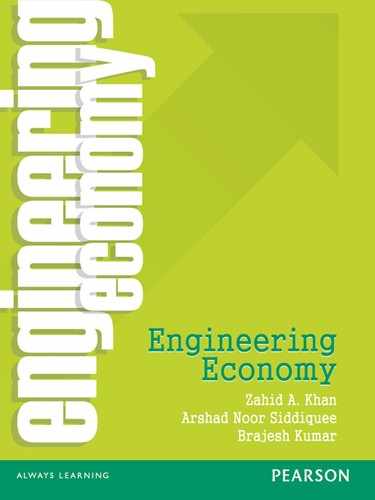PREFACE
ABOUT ENGINEERING ECONOMY
Engineers are required to provide economically feasible solution to the existing problems. To achieve this, engineers must possess knowledge of engineering economy to evaluate the monetary consequences of the products, projects and processes that they design. Engineering design solutions do not exist in a vacuum but within the context of a business opportunity. But every problem has multiple solutions, so the issue is—how does one rationally select the design with the most favourable economic result? The answer to this question is provided by engineering economy. Engineering economy, the analysis of the economic consequences of engineering decisions, was originated by A. M. Wellington in his The Economic Theory of Railway Location, published in 1887. Engineering economy is now considered a part of the education of every engineer, as it provides a systematic framework for evaluating the economic aspects of competing design solutions. Just as engineers model the effect of temperature on cutting tools, or the thermodynamic response of an air compressor, they must also model the economic impact of their recommendations. Engineering economy—what is it, and why is it important? The initial reaction of many engineering students to these questions is, ‘money matters will be handled by someone else and I need not to worry about these matters'. In reality, any engineering project must be, not only physically realizable but also economically affordable. Understanding and applying economic principles to engineering have never been more important. Engineering is more than a problem-solving activity focusing on the development of products, systems, and processes to satisfy a need or demand. Beyond function and performance, solutions must also be economically viable. Design decisions affect limited resources such as time, material, labour, capital, natural resources, not only initially i.e. during conceptual design but also through the remaining phases of the life cycle i.e. detailed design, manufacture and distribution, service, retirement and disposal. Engineers should realize that solution provided by them does not make sense and not acceptable, if it is not profitable.
EDUCATION LEVEL AND USE OF TEXT
The contents of this book have been designed in such a way that it serves two primary purposes: (1) to provide students with a sound understanding of the principles, basic concepts, and methodology of engineering economy; and (2) to help students develop proficiency with these methods and with the process for facilitating rational decisions they are likely to encounter in professional practice. Interestingly, an engineering economy course may be a student's only college exposure to the systematic evaluation of alternative investment opportunities. In this regard, Engineering Economy is intended to serve as a text for classroom instruction and as a basic reference for use by practicing engineers in all specialty areas (chemical, civil, computer, electrical, industrial, and mechanical engineering). The book is also useful to people engaged in the management of technical activities.
It is well suited for undergraduate as well as postgraduate courses in engineering economic analysis, project analysis, or engineering cost analysis. Additionally, because of its simple and easy to understand language, it is perfect for those who are studying the subject for the first time and on their own, and for those who simply want to review. The systematic approach used in the text's design allows a practitioner unacquainted with economics and engineering principles to use the text to learn, understand, and correctly apply the principles and techniques for effective decision making.
SALIENT FEATURES OF THE BOOK
Special features of this book include the following:
- Simple and easy to understand language has been used in the book.
- The concepts have been explained in lucid manner.
- Numerous comprehensive real life examples appear throughout the book.
- Extended learning exercises appear in the end-of-chapter problem sets.
- Illustrations are enriched with enough number of figures and diagrams.
- A few special chapters such as “Chapter 2: Fundamental concepts of mathematics and engineering economics, Chapter 3: Basic mathematical concepts for economic analysis, Chapter 12: Project management, and Chapter 14: Forecasting” which generally do not appear in Engineering Economy texts are included in this book.
ZAHID A. KHAN
ARSHAD NOOR SIDDIQUEE
BRAJESH KUMAR
